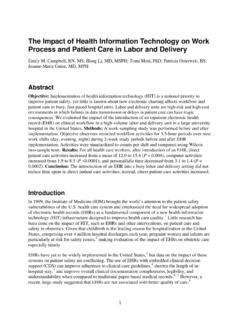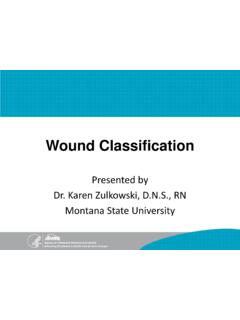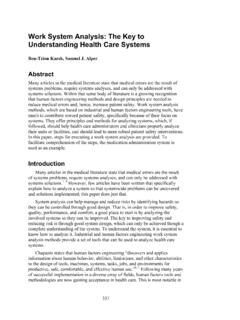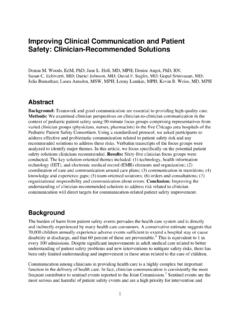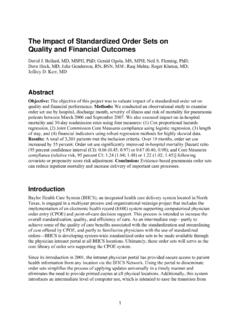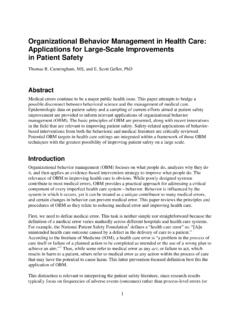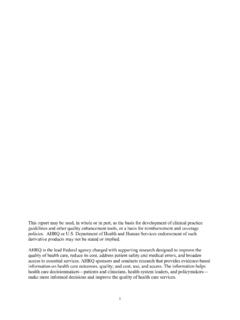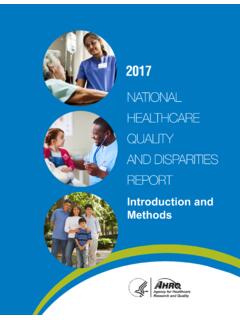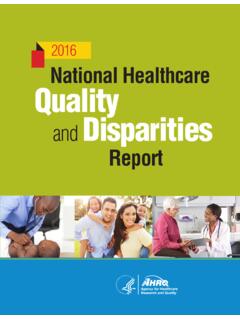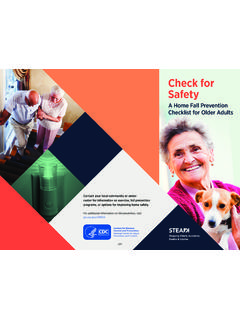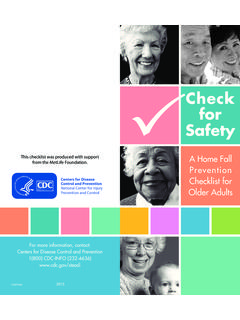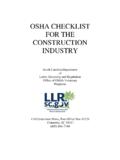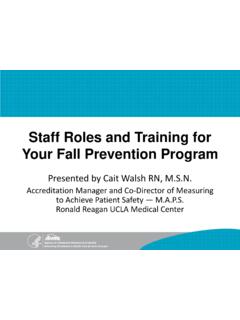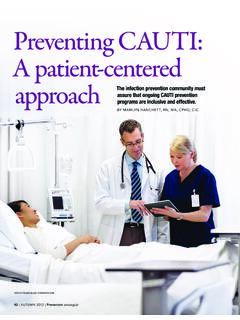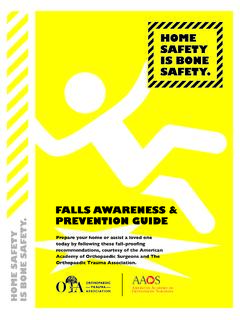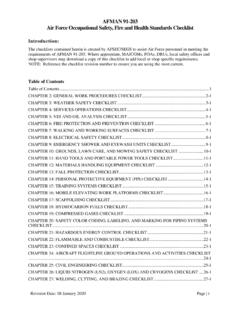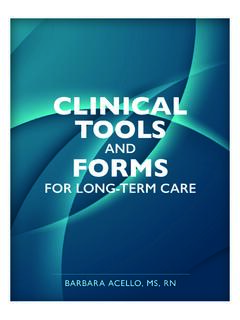Transcription of Measuring Fall and Fall-Related Injury Rates and ...
1 Measuring fall and Fall-Related Injury Rates and prevention PracticesPresented by Julia Neily, RN, , Health Administration National Center for Patient SafetyWelcome!Thank you for joining this webinar about how to measure fall and Fall-Related Injury Rates and fall prevention Little About Work for VHA National Center for Patient Safety Have been a nurse since 1984 Have worked with numerous teams in fall breakthrough series3 Today We Will Talk About Purpose of measurement Types of falls Types of falls to focus on Measuring fall and Fall-Related Injury Rates Measuring fall prevention practices4 These topics were introduced in your 1-day training.
2 Today, we will revisit them in make a note of your questions. Your Quality Improvement (QI) Specialists will follow up with you after this webinar to address them. Purpose of MeasurementMeasuring fall and Fall-Related Injury Rates and fall prevention practices tells you If any areas of care can be improved If you are meeting your aims If your changes are an improvement If you sustain your improvementsIf you can t measure it, you can t improve it!5 Types of Falls Accidental fallsMay be caused by Extrinsic environmental risk factors or hazards Spills, clutter, tubing/cords Errors in judgment Not paying attentionAction: Determine of FallsAnticipated physiological fallsMay be caused by Known fall risks as indicated on the Morse fall Scale Loss of balance, impaired gait or mobility, impaired cognition/confusion, impaired vision, history of falls, decreased mobility upon assessmentAction.
3 Determine of FallsUnanticipated physiological fallsMay be caused by Factors associated with unknown fall risks that cannot be predicted on a fall risk scale Unexpected orthostasis, extreme hypoglycemia, stroke, heart attack, seizure Action:This type of fall is not of Falls To Focus On Report falls by type. Examine trends in preventable falls. Example: Toileting-related falls Implement interventions related to the trend identified. Examine repeat falls. 9 Measuring fall and Fall-Related Injury Rates What to count Measures used Data needed How often to calculate Improving data10 What To Count for fall and Fall-Related Injury Rates Totalnumber of falls on your unit.
4 Agree on a definition of fall . Number of repeatfalls on your unit. Level of Injury for each fall . Number of occupied bed days on your unit over a given period of time. 11 Measures Used for fall and Fall-Related Injury RatesSuggested approach Total falls per 1,000 occupied bed days Injurious falls per 1,000 occupied bed daysThere are many ways to measure fall and Fall-Related Injury Rates . The most important thing is to be consistent. 12 See Section (page 77) of the Toolkit for a link to the National Database of Nursing Quality Needed for fall and Fall-Related Injury RatesFor each fall , create an incident report that tells Fact that the incident being reported is a fall Name of the patient who fell Where the patient fell When the patient fell Unit the patient was assigned to when he/she fell Circumstances of the fall (in detail) Injury level of the fall13 Refer to Tool 5A.
5 Information to Include in Incident ReportsData Needed for fall and Fall-Related Injury RatesYou ll also need to know the number of occupied beds on your unit each is easier if your hospital has a computerized system. If not: Choose a time of day. Each day at that time, check the number of occupied beds on your unit. Write down that number. 14 How Often To Calculate fall and Fall-Related Injury RatesCalculate fall and Fall-Related Injury Rates one time each month, if to Toolkit Section To Calculate fall and Fall-Related Injury RatesExample: fall rate for month of incident reports, figure out the total number of falls on your unit during April.
6 Out the number of occupied beds on your unit per day during April. up the total number of occupied beds on your unit in April by adding up all the beds per day from Step 2. If your hospital can give you the total, you can skip Step 2. the total number of falls by the total number of occupied beds on your unit in April. this number by 1, To Calculate fall and Fall-Related Injury RatesExample: fall rate for your unit in month of AprilTotal number of falls = 3 Total number of occupied beds = 879. Total number of falls divided by total number of occupied beds = 3 879 = 1,000 = fall rate = falls per 1,000 occupied bed days17 Improving Data for fall and Fall-Related Injury Rates Review completed incident reports with staff each month.
7 Discuss ways to improve, such as giving more details about fall circumstances. Examine trends in root causes. 18 Improving Data for fall and Fall-Related Injury Rates Examine trends in fall Rates such as Falls related to toileting needs Falls related to risk factors (medicines, blood pressure, gait) Falls related to the environment (poor lighting, uneven or slippery floors) 19 Measuring fall prevention PracticesProcess measures Post- fall assessment (huddle) Intentional rounding fall prevention and care planning 20 Refer to Tool 5B: Assessing fall prevention Care ProcessesPost- fall Assessment (Huddle)Clinical review Collects data after a patient falls Seeks to find out if the patient has immediate risk of injuries or other complications May include new fall risk factor assessment with medicine review and lab tests21 Post- fall Assessment (Huddle)
8 Clinical review may include Checks for signs or symptoms of fracture or possible spine Injury before moving patient Safe handling methods for patients with signs or symptoms of fracture or possible spine Injury Regular neurologic checks for all patients with possible or confirmed head Injury Medical exams Sooner for patients who may have serious Injury or who have been immobilized22 Post- fall Assessment (Huddle)Root cause analysis (RCA) Helps you understand why a patient fell Helps you prevent future falls in this and other patients Captures data about a fall from the patient, staff, and other witnesses23 Post- fall Assessment (Huddle)Barriers include Competing commitments Lack of witnesses Multiple causes of a fall Trouble assembling relevant team members24 Post- fall Assessment (Huddle)
9 Strategies include Having a standard protocol that is easily accessible to unit staff Making sure the data gathered with the assessment tool include those needed to file an incident report Having a nurse or pharmacist join rounds to discuss medicines that may have caused the fall25 Post- fall Assessment (Huddle)Ways to document include Care plan Incident reporting system Risk factor profileWays to communicate include Oral handoff Safety huddle26 See Section (page 76) of the Toolkit for an example of the post- fall To Measure fall PreventionData can come from Medical record reviews This approach may be incomplete, because it relies only on the written record.
10 Direct observations of care by trained observer This approach is the most time consuming, but it s also the most accurate. Surveys of staff This approach relies on memory, so it may be To Measure fall prevention Start with a combination of medical record review and direct observation. Use a manageable sample, such as no more than 20 prevention and Care PlanningRemember: Assess fall and Fall-Related Injury risk each time a new patient is admitted. Make sure the individualized care plan is tailored to thepatient s fall risk factors. This targeted approach will reduce the incidence of falls at your hospital and improve the quality of patient care.

